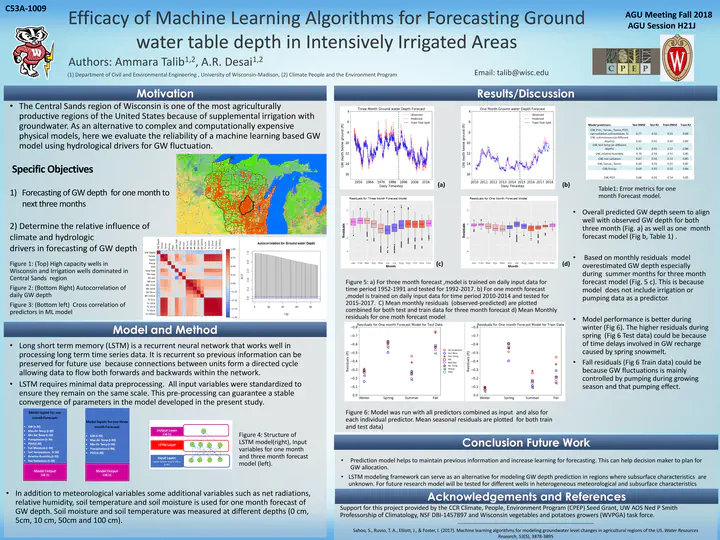Efficacy of Machine Learning Algorithms for Identifying Hotspots of Groundwater Depletion in Intensively Irrigated Agricultural Regions

Conference: ‘American Geophysical Union, Fall Meeting 2018, H21J-1787’
Abstract: The Central Sands region of Wisconsin is one of the most agriculturally productive regions of the United States because of supplemental irrigation with groundwater. About 2,290 high capacity groundwater (GW) wells in shallow sandy and gravel aquifer are being used to irrigate potatoes, sweet corn, peas and bean. These high capacity wells withdraw and pump about 100,000 gallons of water per day and are also draining streams and lakes. Changes in precipitation and temperature has also increased the length of growing season in WCS. Improved understanding of groundwater level response to climate patterns and pumping is essential for sustainable planning and management, particularly in the context of increasing groundwater demands in agriculture. As an alternative to complex and computationally expensive physical models, here we evaluate the reliability of a machine learning based GW model using environmental drivers to GW fluctuation. The objectives were to: 1) develop a new ensemble modeling framework based on artificial neural network nonlinear autoregressive networks to predict spatio-temporal fluctuations of groundwater in WCS, and 2) determine the relative influence of climate variability, evapotranspiration (ET) and crop irrigation demand on GW level change. Precipitation and temperature, streamflow and other climatic indices were chosen as predictors, which make the selected approach easily transferable, since that data is widely available and simple to measure. We trained our model with input data in WCS from 2012-2015 and tested for 2016-2017. Our results show that at least for WCS, our modeling framework can serve as an alternative approach to simulating groundwater level change and water availability, especially in regions where subsurface properties are unknown. An easy to use and rapidly run model also benefits farmers who can identify areas where GW is depleting and thus avoid those regions or grow either non- irrigating crops or crops that recharge GW.Understanding the nonlinear relationship between climate, GW pumping and surface water is also crucial for scientist and conservation professionals, to help protect areas with potential for highest GW depletion. A future application of this work will be to predict crop yield by identifying the important drivers that affect GW level.